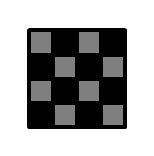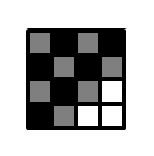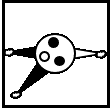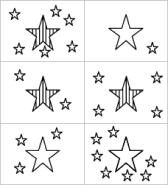Updated January 2025
The UCAT (University Clinical Aptitude Test) is the admissions test for medical students in the UK, Australia and New Zealand. It aims to assess the candidates’ suitability for studying medicine by evaluating their behaviour and cognitive abilities.
This UCAT practice test features questions that closely simulate those on the actual UCAT. Carefully selected from our comprehensive UCAT practice pack, these sample questions will familiarize you with the different types of UCAT questions: Verbal Reasoning, Decision-Making, Quantitative Reasoning, Abstract Reasoning, and Situational Judgment.
Testing is open from 8 July to 26 September, with the final booking deadline on 19 September. Explore our UCAT preparation pack for comprehensive preparation for all UCAT exam questions, including expert feedback and tips.
UCAT Practice Test
The UCAT exam comprises 184 multiple-choice questions and takes about 2 hours to complete:
| UCAT Test Section | Number of Questions | Time Limit |
| Verbal Reasoning | 44 Questions | 21 Minutes |
| Decision Making | 29 Questions | 31 Minutes |
| Quantitative Reasoning | 36 Questions | 25 Minutes |
| Abstract Reasoning | 50 Questions | 12 Minutes |
| Situational Judgment | 69 Questions | 26 Minutes |
In the UCAT practice test below, we will guide you through each section using a sample from our full UCAT preparation.
UCAT Decision-Making Test Questions
The UCAT Decision-Making section assesses your ability to use and apply logic to analyze statistical data, evaluate information, and reach conclusions. The questions are stand-alone, meaning no information is used for more than one question, and they vary in content.
There are six types of UCAT decision-making questions:
- Logical puzzles
- Syllogisms
- Venn diagrams
- Recognizing assumptions
- Probabilistic and statistical reasoning
- Interpreting information
Below are three of the six topics found in the section:
1. Read the following text and answer the question:
A kindergarten is arranging the children's birthday schedule.
The following facts are known:
- Gabriel is younger than Davis.
- Liz is younger than Sarah.
- Katie is older than David but younger than Sarah.
- Liz is younger than Katie.
Which of the following MUST be true?
A) Liz is older than David
B) Gabriel is the youngest child in the kindergarten
C) Liz is the second youngest child in the kindergarten
D) Katie is the second oldest child in the kindergarten
Answer:
The correct answer is D.
If you arrange the information given in two inequalities:
Gabriel < David < Katie < Sarah
Liz < Katie
You can conclude that Sarah is the oldest child, and since Katie is older than everyone except Sarah, she is the second oldest child.
Since you don't know if Liz is older, younger, or between the ages of David and Gabriel, statements (A), (B), and (C) are all incorrect.
2. Choose ‘Yes’ if the conclusion follows and ‘No’ if the conclusion does not follow.
Stealing is punishable only if it results in getting caught. Stealing is not punishable when thieves are being careful. Stealing can sometimes result in being caught. Thieves are mostly careful, so they don't get caught.
A) Stealing is unethical.
1. Yes
2. No
B) Stealing is punishable when thieves are being careful.
1. Yes
2. No
C) Thieves are usually not punished.
1. Yes
2. No
Answer:
A. The correct answer is ‘No.’ You know nothing about the ethical aspect of stealing from the text.
B. The correct answer is ‘No.’ It is stated that stealing is not punishable when thieves are being careful.
C. The correct answer is ‘Yes.’ The statements 'Stealing is not punishable when thieves are being careful' and 'Thieves are mostly careful so they don't get caught” imply that most of the time thieves are not punished.
3. Answer the question below based on the following information:
There are two dental clinics in the neighborhood.
- In clinic A, there is a 50% chance of waiting for more than two hours.
- About 200 of the 1000 patients who go to clinic B reported waiting less or equal to two hours.
- In clinic A, 25 out of 100 patients were satisfied with the service they received.
- In clinic B, three-quarters of the patients were unsatisfied with the service they received.
Considering only the likelihood of waiting and the satisfaction level, is clinic B the better clinic choice?
A) Yes, clinic B's waiting time is shorter.
B) Yes, clinic B's satisfaction level is higher.
C) No, the chance of waiting more than two hours is 50% for clinic A as compared to 80% for clinic B.
D) No, the satisfaction level in clinic A is higher than in clinic B.
Answer:
The correct answer is C
Compare both waiting time and satisfaction level separately for each clinic:
Waiting time –
Clinic A: 50% chance of waiting more than two hours.
Clinic B: 200 out of 1000 patients wait less or equal to two hours = 800 out of 1000 wait more than two hours = 80% wait more than two hours.
In clinic B, the waiting times are longer than in clinic A.
Satisfaction –
Clinic A: 25 out of 100 patients satisfied = a quarter of patients satisfied.
Clinic B: Three-quarters of the patients unsatisfied = a quarter of patients satisfied.
The satisfaction levels are identical in both clinics.
UCAT Tip: For most of the decision-making questions, such as the seating arrangement and the syllogisms, writing down and drawing a diagram of the process presented to you will make it easier for you to reach the correct answer and receive a good UCAT score.
Unsure How to Prepare for the UCAT Exam?
With our comprehensive UCAT preparation course, you can refine your techniques, enhance your logical abilities, and increase your UCAT percentile. Our PrepPack is tailored to maximize your practice:
- Find out where you can improve the most, by taking a diagnostic test.
- Focus your UCAT practice on specific areas with 36 cognitive practice tests organized by topic and detailed study guides for each section.
- Experience the real UCAT test conditions with 2 complete UCAT simulations.
- Tackle any scenario on the situational judgment and personality tests with expert tips and guidance from our psychometric specialists.
★ 4.2 (23 reviews) | 2000+ already enrolled
UCAT Situational Judgement Test Questions
The UCAT Situational Judgement section is designed to assess your behaviour and values, predicting your performance as a physician based on your responses to scenarios that medical doctors may encounter throughout their careers.
You will be presented with a series of scenarios set in a clinical environment or medical training, followed by several optional responses.
UCAT situational judgment questions are particularly challenging due to their varied formats and unique scenarios. With only 26 seconds per question, you must read the scenario, understand the question and options, contemplate, and respond accordingly. Yet, it is likely the most crucial part of the UCAT and has the greatest impact on achieving a high score.
1. Noah is a student who is about to perform a medical procedure on a patient in front of his classmates and a supervisor. Just before the procedure begins, Noah's father informs him by text that his grandfather is in a very bad condition and asks him to contact them as soon as possible. Noah is extremely concerned about this situation and wants to assist his family.
How important is the following consideration for Noah to consider while deciding what to do next?
The patient's safety.
A) Very important
B) Important
C) Of little importance
D) Not important at all
Answer:
Patient care is the most important factor in medicine, so it’s a very important consideration.
2. A man complaining about headaches arrives at a medical clinic. Lauren, a junior doctor, treats him. After the treatment, the man continues complaining about the pain, but Lauren finds nothing wrong with him.
How important is the following consideration for Lauren to consider while deciding what to do next?
Lauren wishes to seem like a qualified doctor.
A) Very important
B) Important
C) Of little importance
D) Not important at all
Answer:
It is important for a doctor to have the ability and integrity to admit when they don’t know something. Lauren's desire to prove herself or her appearance in front of the patient is irrelevant, so this consideration is not important at all.
3. Laura is a medical resident in the surgical department. After a big accident happened near the hospital, all non-critical surgeries for the day were delayed helping treat new patients who were wounded. Laura is asked to talk to Dave, a patient who has been waiting very nervously for a tumour removal for the past 3 weeks and tell him that his surgery would be delayed to the following day, to first in the morning. The delay wouldn’t further endanger Dave, and Laura comes to his hospital bed to inform him of the delay.
How appropriate is the following response by Laura to this situation?
Ask that Dave return tomorrow morning and wait with his questions until then – since the medical staff is preoccupied with the accident.
A) A very appropriate thing to do
B) Appropriate, but not ideal
C) Inappropriate, but not awful
D) A very inappropriate thing to do
Answer:
This option shows an absolute lack of understanding of Dave's fears and struggles, as he is very nervous before a serious surgical procedure.
It is stated that Dave has waited some time for the surgery and is nervous about it. This option shows no empathy on Laura's behalf – she is expected to tell him the reason for the delay, reassure him that the delay will not endanger him whatsoever, and explain the sudden situation and the critical need for the medical staff to provide aid to the injured from the accident. Also, Laura should allow him to express himself so he can feel acknowledged and verbalize his emotions and struggles. Therefore, it is a very inappropriate thing to do.
UCAT Tip: Read carefully and know which character the question refers to in the scenario. The correct answer may differ according to the character's position within the scenario.
The Decision-making and situational judgment test sections measure qualities expected of a medical doctor, such as empathy, decision-making with the patient's well-being in mind, and integrity. Many applicants struggle with this part of the test due to its unique scoring system, which is separate from the cognitive scoring. Therefore, it is highly recommended that you become familiar with it.
We believe the best way to prepare for and tackle this section is by learning and practising a unique toolkit—the Doctor's Leadership Principles. Assembled by our behavioural test experts and medical students, these principles are designed to help you handle different scenarios. You can learn about these principles and practise using them in our full UCAT prep course.
UCAT Abstract Reasoning Test Questions
The UCAT Abstract Reasoning section is often regarded as the most challenging cognitive part of the UCAT exam due to its complexity and the challenge of answering all (or even most) questions within the time limit. It requires unique skills, adaptability to various question styles, and management of mental fatigue from previous sections.
1. choose the right answer:

a.

b.

c.

d.

Answer:
The correct answer is d. In this series, a diagonal row of small squares is filled in each frame, alternating in grey and black colours. Since the last diagonal line filled in was black, the answer will contain an additional grey diagonal row.
2. Answer the question below based on the following sets:

Which of the following belongs in set B?




Answer:
The correct answer is C.
The rules for set B are as follows:
Every black dot inside the circle represents a white ray that points away from the circle. Each rat has a cloud at its pointy end.
Every white dot inside the circle represents a black ray that points away from the circle. Each ray has a cloud at its pointy end.
The direction or position of the rays and dots does not matter.
Answer (A) is incorrect because the two rays should be black and pointing away from the circle, as there are two white dots.
Answer (B) is incorrect because there should be two white rays and one black ray, as there are two black dots and one white dot.
Answer (D) is incorrect because there should be two black rays and one white ray pointing away from the circle, as there are two white dots and one black dot.
Note that answers (A), (B), and (D) all belong in set A, but you were asked about set B.
Remember, once you’ve found the correct answer, mark it and move on.
3. Answer the question below based on the following sets:
Set A

Set B

This shape

belongs to:
A) Set A
B) Set B
C) Neither
Answer:
Set A: When the large star is dotted, there is an odd number of small stars. When it is empty (white), there is an even number of small stars.
Set B: When the large star is striped, there is an even number of small stars, and when it is empty (white), there is an odd number of small stars.
The large star is empty, and the number of small stars is odd (5), thus, the test shape belongs to set B.
UCAT Tip: To identify a set's logic, focus on just two or three squares of the set. Find which rules and logic govern these squares and apply them to the rest of the set to see if they follow the same rules and logic.
Specific answering tips and practice of these abilities, which will help you receive a high UCAT score, can be gained with guides and practice tests in our full UCAT prep course.
UCAT Quantitative Reasoning Test Questions
In the Quantitative Reasoning section of the UCAT, you will need to perform mathematical calculations, tackle numerical word problems, and interpret graphs and tables. This section often challenges many due to its demanding transition between different mathematical tasks.
Use the following table to answer the questions:
2005 Results of the 'Daily Magic' Newspaper Global Delivery
| Successfully Delivered Newspapers (Excluding Lost) Per Day | Per cent of Newspaper Lost During Delivery | Number of Couriers Working Annually | |
|---|---|---|---|
| London | 12,504 | 5% | 758 |
| Sydney | 7,704 | 11% | 321 |
| Paris | 8,007 | 13% | 569 |
| New York | 15,600 | 6% | 358 |
| Milan | 3,069 | 8% | 259 |
1. How much does it cost to deliver a newspaper successfully in Sydney (excluding lost papers)?
A) 1.2$
B) 1.6$
C) 1.8$
D) 2.2$
E) Cannot Say
Answer:
There is no information about newspaper prices; therefore, we can’t figure out the answer based on the existing data.
The answer is Cannot Say.
2. Disregarding newspaper loss rates, how many couriers from Sydney would have been needed to deliver the same number of newspapers as in London successfully?
A) 512 Couriers
B) 513 Couriers
C) 521 Couriers
D) 523 Couriers
E) Cannot Say
Answer:
In Sydney, there are 321 couriers delivering 7,704 newspapers successfully.
7704 / 321 = 24 newspapers per courier
In London, 12,504 newspapers are delivered successfully.
Dividing the 12,504 by 24 gives us the number of couriers required for this task:
12,504 / 24 = 521 couriers
The answer is 521 Couriers.
3. What would Sydney’s lost rate have to be to match the daily number of successful deliveries in Paris?
A) 5%
B) 7.5%
C) 10%
D) 15%
E) They will never match.
Answer:
With a loss rate of 11%, the 7,704 newspapers that are successfully delivered in Sydney make up 89% of the total newspapers delivered (100% -11%).
The total number of deliveries in Sydney (including lost papers) is (7,704 × 100) / 89 = 8,656.
In Paris, 8,007 newspapers are delivered successfully. For Sydney to have the same number of successfully delivered papers, Sydney must lose only 8,656 - 8,007 = 649 newspapers. Therefore, the new Sydney lost rate must be (649 / 8,656) * 100% = 7.5%.
UCAT Tip: There will be questions in which there is no option which is 100% correct. For example, you will notice imprecise decimal figures. In these cases, you need to choose the best, most suitable answer. If you cannot find one, recheck your solution.Keep in mind that any wrong answer will reduce your UCAT percentile.
The UCAT Quantitative Reasoning section includes 36 questions to be answered in 25 minutes, meaning you will have approximately 41 seconds for each question. To answer quickly, make sure you know your math and refine your calculating skills. Make sure you can make basic calculations, especially percentages, portions, ratios and formulas for volume and area. You can master those skills and more while practising a variety of tables and graphs by using our full UCAT prep course.
UCAT Verbal Reasoning Test Questions
In the Verbal Reasoning section, you will be given 11 passages of text, each followed by four questions. You’ll have an average of 30 seconds to answer each question.
Unlike the Decision-Making section, which concentrates on specific details, the Verbal Reasoning section emphasizes understanding broader concepts within lengthy and varied texts. With less than 30 seconds allotted for each question, it can be very challenging to answer all questions fully.
Text I
Lily Beetles (Galercuella Nymphaeae) are extreme water skiers. They can skim across the surface of water so fast that they seem to vanish.
Trying to figure out how they stay on the surface while traveling at speeds of up to 0.5 metres per second, a researcher from Stanford University has filmed the beetles in the lab. Scaled for size, the beetles' speed would be equivalent to a human traveling at about 500km/h.
When a beetle "takes off", it lifts its middle legs, and then angles its body upwards before vigorously flapping its wings to launch itself horizontally, traveling up to a few metres forwards. It moves so fast that it interacts with the ripples generated by its own motion, which increases drag and allows it to jump from ripple to ripple.
Understanding the motion of the beetles could help us develop robots and other vehicles that move across water quickly.
1. The Lily beetle is the fastest water bug known to science.
A) True
B) False
C)Cannot Say
Answer:
The correct answer is Cannot Say.
Although it is stated in the passage that the Lily beetle is an extremely fast bug, the passage does not mention that it is the fastest one known.
2. Understanding the motion of Lily beetles can have practical implications
A) True
B) False
C)Cannot Say
Answer:
The correct answer is True.
According to the passage, "Understanding the motion of the beetles could help us develop robots and other vehicles that move across the water quickly.” This understanding has practical implications.
Text II
A study published in the Journal of Psychological Science found that living in greener areas is correlated with higher levels of mental well-being and life satisfaction. The study used data from a national survey that followed more than 5,000 households and 10,000 adults between 1991 and 2008 as they moved around the country. The researchers accounted for changes over time in participants' income, employment, marital status, physical health, and housing type. The results showed that living in an urban area with high levels of green space can significantly positively impact well-being, equivalent to a third of the impact of being married.
Beth Murphy, a local manager in a mental health institution, said: "For people living busy lifestyles in densely populated areas, being able to get outdoors and access green space is a great way to escape the stresses of day-to-day life." This research is important to psychologists, public health officials, and urban planners interested in learning about the effects of urbanization and city planning on population health and wellbeing.
3. What conclusion can be drawn from the passage?
A) People in densely populated areas have poor health.
B) Marriage does not have a significant impact on well-being.
C) The positive impact of green spaces is moderated by physical health.
D) Not all people have access to green areas.
Answer:
The correct answer is D.
The question requires us to make inferences from the information given in the passage. In addition, it does not refer us to a specific section of the text. Therefore, it is recommended to work with the statements themselves and locate them in the text (trying to confirm or refute them) instead of vice versa.
Statement D states, ' A study … found that living in greener areas correlates with higher levels of mental well-being and life satisfaction.’ The study gives us reason to infer that green spaces are not accessible to all people, as not everyone is able to achieve such conditions.
The full-length text and questions, which resemble the actual test, can be found below.
Therefore, the statement that logically follows from the passage is statement D.
UCAT Tip: The UCAT verbal reasoning subtest has two types of questions – true/false/cannot tell and free text questions. Although the true/false/cannot tell might seem the easy ones, in fact, they are trickier because you need to be 100% sure that your conclusion lies within the text and that you do not rely on your assumptions or previous information. A not-text-based question can significantly affect your UCAT percentile.
Improving your verbal skills, inference abilities, and techniques for speeding up your responses can significantly boost your UCAT average score.
What is the Best Way to Study for the UCAT?
Our psychometric experts and medical students have developed and refined an online UCAT practice pack to closely simulate the challenges you'll encounter on the actual test.
Personalized Practice for your Best Score
Identify weak areas using a diagnostic test and focus your practice to achieve your best possible score.
Focused Practice & Time Management
Develop effective solving techniques and time-saving strategies to tackle challenging questions under pressure.
Expert Guidance for Optimal Answers
Resolve medical decision-making dilemmas with principles guide and answer feedback.
UCAT Exam Scores
The UCAT results are based on a standard distribution, comparing your performance to the average of all test takers.
Different medical schools have varying UCAT score requirements, with more prestigious schools having higher standards.
Your overall UCAT score is composed of two parts:
- Cognitive Sections: Each of the 4 sections scores between 300 and 900, with a total score range of 1,200-3,600. The median score in 2022 was around 2,500.
- SJT Section: This section is scored in 4 bands, with band 1 being the highest and band 4 the lowest.
What UCAT Score Do I Need to Pass the UCAT?
This is difficult to answer, wildly dependent on the specific university in question. However, a cognitive score of 2,600 and band 1/2 are considered a good UCAT score for most (though more prestigious places like Oxford may require higher performances).
💡 Learn more about the UCAT Scores
UCAT FAQs
The Pearson VUE based test can be taken by registering ahead of time on the official UCAT website. You will be asked to write a personal statement during your UCAS application explaining your motivation to become a medical practitioner.
To take the UCAT exam, you must:
Complete/be in the final year of your higher secondary education (higher than that is also fine.)
Be eligible for medical programs at chosen Universities in the UK, Australia, and New Zealand.
More than 20 medical schools and universities in the UK use the UCAT test format to screen for their medical and dental courses.
The UCAT is not a free test to take- the cost in the UK is £70, and £115 in Australia and New Zealand.
This page is about the admission test for medical students in the UK. Are you taking the UCAT by Criteria? Check out our dedicated page on Universal Cognitive Aptitude Test preparation.




